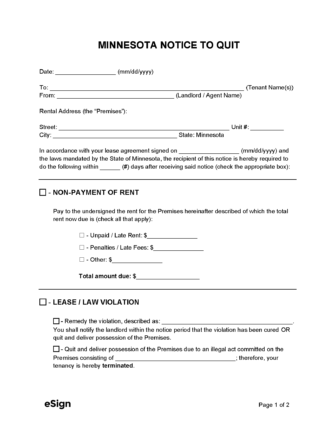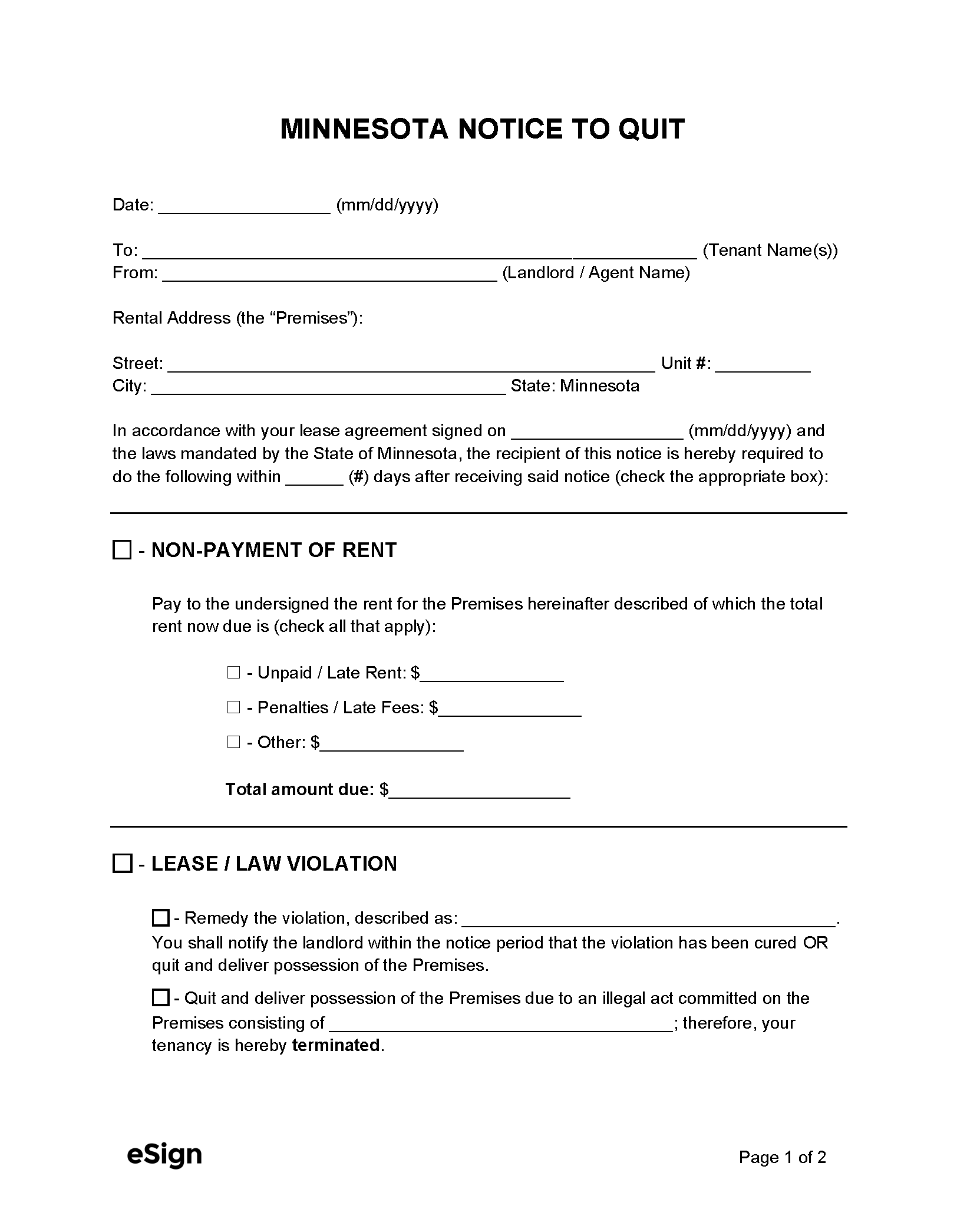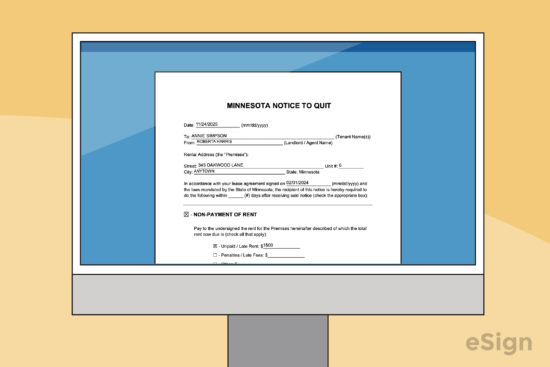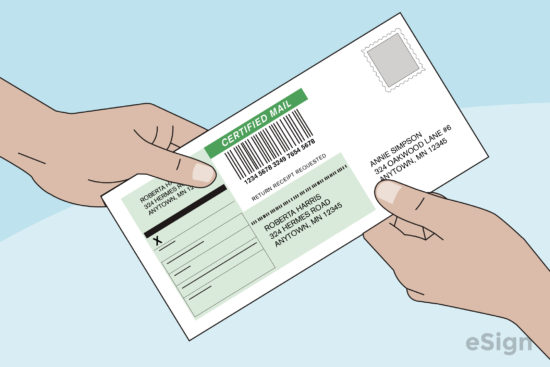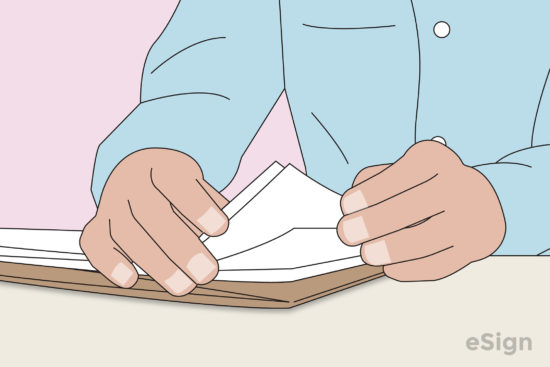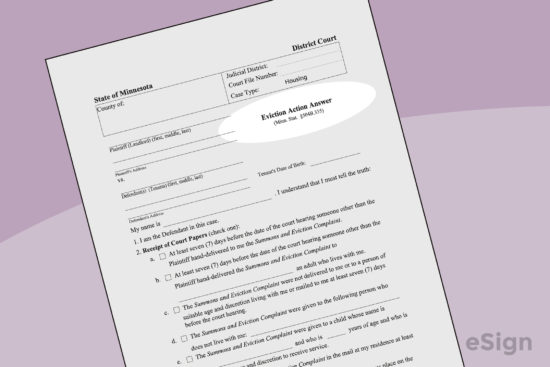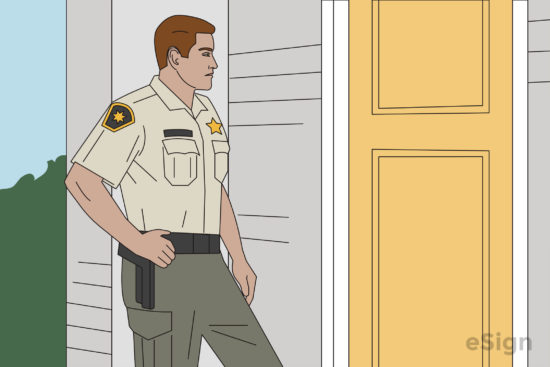A Minnesota eviction notice informs a tenant that there is legal cause to terminate their tenancy and that, if they don’t comply with the requirements stated in the notice, the landlord may file an eviction lawsuit to recover possession of the property. Depending on the reason for eviction, the notice may describe the remedial actions the tenant must perform to retain their lease (e.g., pay rent, fix material damage).
The eviction notice will also specify the date by which the notice terms must be satisfied. If the tenant neglects to fulfill their obligations before the expiration of the notice period, the landlord can file an eviction complaint with the district court (or housing court depending on the jurisdiction) to evict them from the property.
By Type (5)
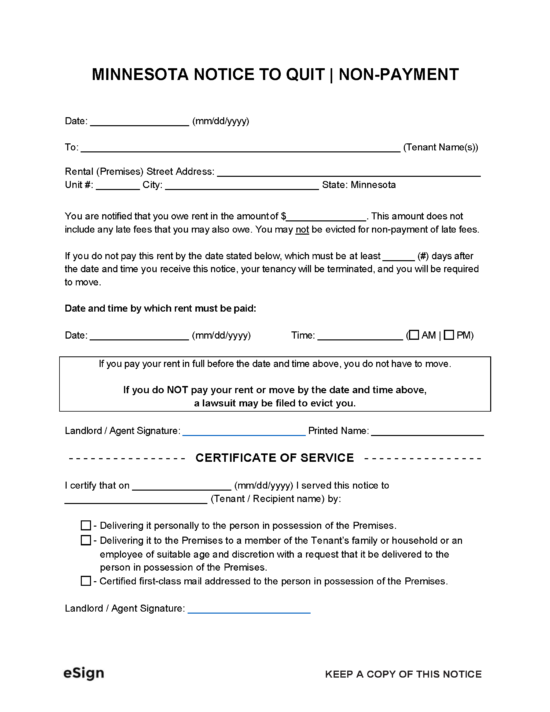
Download: PDF, Word (.docx), OpenDocument
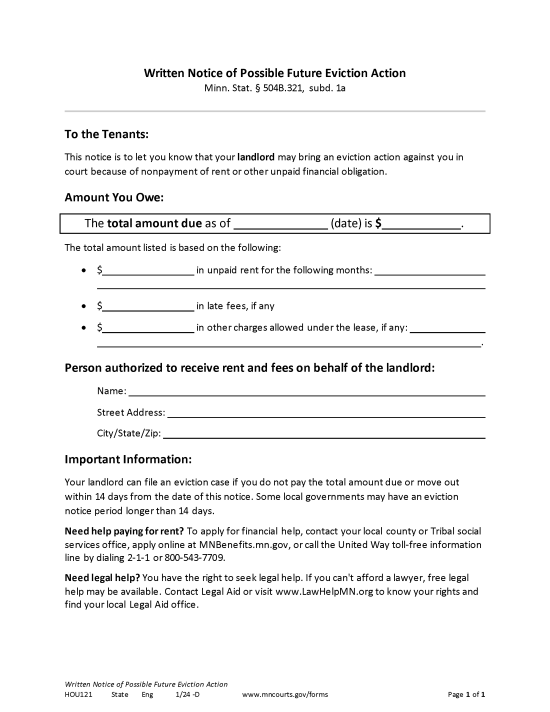
Download: PDF, Word (.docx), OpenDocument
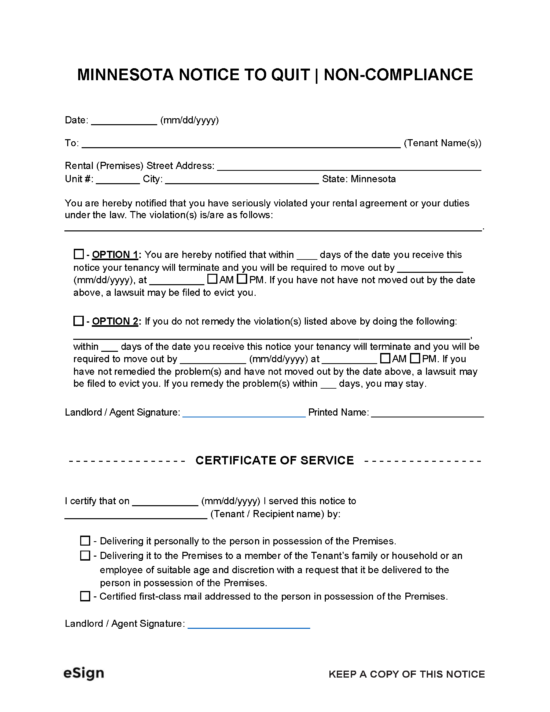
Download: PDF, Word (.docx), OpenDocument
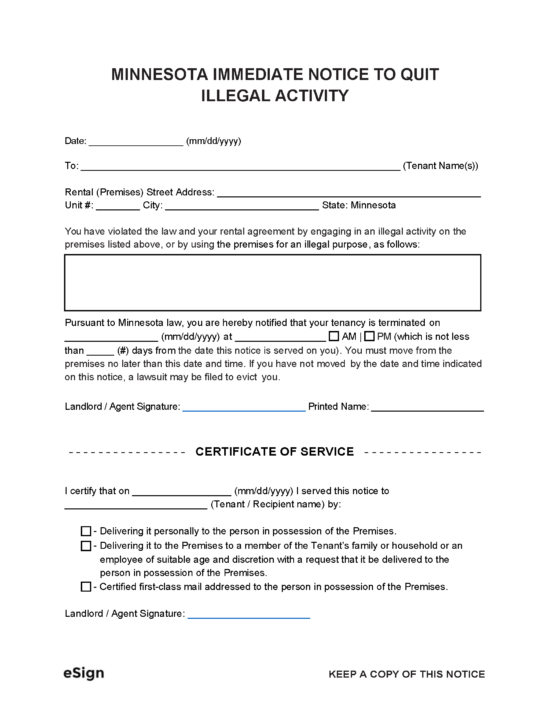
Download: PDF, Word (.docx), OpenDocument
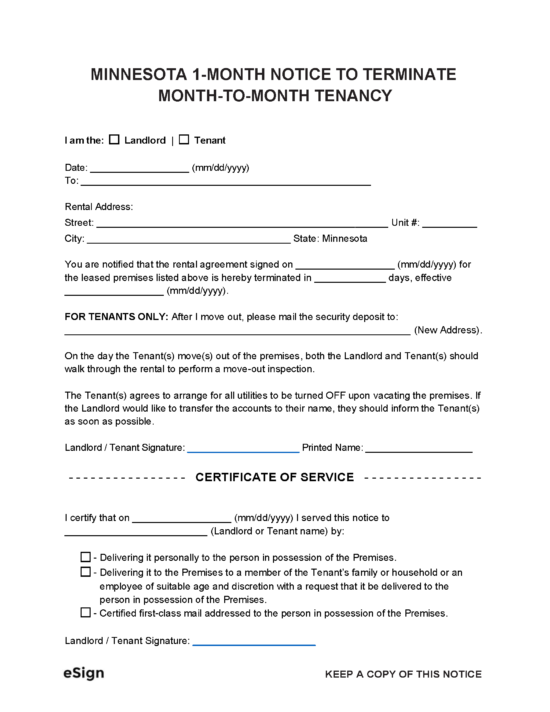
Download: PDF, Word (.docx), OpenDocument
Contents |
Eviction Laws + Required Notices
- Grace Period (§ 504B.177): No Notice Required
- Non Payment of Rent (Fixed-Term Tenancy) (§ 504B.291): No Notice Required
- Non-Payment of Rent (At-Will Tenancy) (§ 504B.135): Fourteen (14) Days
- Lease Non-Compliance (§ 504B.285(Subd. 4)): No Notice Required
- Illegal Activity (§ 504B.171): No Notice Required
- Periodic Tenancy Termination (§ 504B.135): Three (3) Months or One (1) Rent Period
How to Evict a Tenant
Evictions in Minnesota are granted by the court through a legal process known as an “eviction action.” Landlords can only initiate an eviction action when they have legal grounds to do so, such as when the tenant is late on rent or remains on the property after the expiration of their tenancy. While not required in all cases, the landlord will typically start the process by serving the tenant with a written eviction notice.
Step 1 – Prepare Notice to Quit
An eviction notice, or “notice to quit,” conveys the eviction details to the tenant. The landlord must download and prepare the eviction notice that corresponds with the cause for lease termination.
- Notice to Quit for Non-Payment (Fixed-Term Tenancy) – Not Legally Required
- 14-Day Notice to Quit for Non-Payment (At-Will Tenancy)
- Notice to Quit for Non-Compliance
- Immediate Notice to Quit for Illegal Activity – Not Legally Required
- Notice to Terminate Month-to-Month Lease
In the case where an eviction notice is not legally required (as indicated above), the landlord can file for eviction without notice, although some landlords will still provide notice as an act of goodwill towards the tenant.
Step 2 – Serve Notice to Quit
The landlord must serve the notice to quit to the tenant to inform them of the eviction details. The best option for service is to personally deliver the notice in the presence of a disinterested witness, but it might also be possible to deliver it by certified mail or to simply post it to a conspicuous location on the premises. Some jurisdictions may impose unique service requirements; landlords should speak with a court administrator to learn the service methods for their county.
Step 3 – File Eviction Complaint
Tenants will need to pay rent, fix a lease violation, or vacate the property before the expiration of the notice period (if any). Should they fail to comply, the landlord must file an Eviction Action Complaint (HOU102) with a court administrator and pay a filing fee. Included with the complaint must be copies of the notice to quit, the lease, the police report (if applicable), and a power of authority.* If there are more than two (2) filers and/or tenants, an Additional Litigants Form (HOU125) shall be included with the complaint.
*Used in Hennepin County and Ramsay County only.
Step 4 – Serve Summons
After the complaint is filed, a Summons will be issued and the court will schedule a hearing date. The landlord must arrange to have the Eviction Action Complaint and Summons served on the tenant by a neutral party who is aged eighteen (18) or above. Alternatively, the landlord can hire a process server or the sheriff to serve the papers. Separate copies of the Eviction Action Complaint and Summons must be served on each tenant at least seven (7) days before the eviction hearing. The landlord must then file a separate Affidavit of Service for each tenant no less than three (3) days before the hearing date.
The list below contains the different Affidavits of Service accepted by the court. The Affidavit filed by the landlord must correspond with the method of service used to deliver the Eviction Action Complaint and Summons.
Step 5 – Answer Eviction Summons
The Summons will notify the tenant that an eviction lawsuit has been filed and that they must appear in court on the hearing date. To defend their case, the tenant will need to complete an Eviction Action Answer (HOU202) and provide it to the court at the eviction hearing. There should be three (3) copies of the Eviction Action Answer: one (1) for the tenant, one (1) for the landlord, and one (1) for the judge.
Step 6 – Eviction Hearing
The landlord and tenant must appear in court on the hearing date to present their cases to the judge. If either party fails to attend, a ruling may be made in favor of the party in attendance. Some county courts may schedule a separate trial to allow the parties to present their witnesses. However, most eviction cases will be resolved during the initial hearing.
Step 7 – Writ of Recovery of Premises and Order to Vacate
If the court rules to evict the tenant, the landlord must request a Writ of Recovery of Premises and Order to Vacate from the court (a Writ fee will be required). The landlord must take the Writ to the sheriff and ask to have it served on the tenant. After the Writ is served, the tenant will have twenty-four (24) hours to remove their belongings and vacate the property after. If the tenant ignores the Writ, the landlord must schedule a date for the sheriff to visit the property and physically remove the tenant from the premises.
Court Forms + Resources
Forms
- Eviction Action Answer (HOU202)
- Signing: Tenant
- Additional Litigants Form (HOU125)
- Signing: N/A
- Eviction Action Complaint (HOU102)
- Signing: Landlord
- Power of Authority in Eviction Action in Ramsey County Housing Court (HOU103)
- Signing: Landlord
- Power of Authority in Eviction Action in Hennepin County Housing Court (HOU103)
- Signing: Landlord
-
- Signing: Service Person
-
- Signing: Service Person
-
- Signing: Service Person
-
- Signing: Service Person
- Writ of Recovery of Premises and Order to Vacate
- Signing: N/A
- Summons
- Signing: N/A
